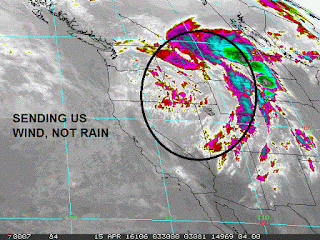Spring has sprung.
SURF:
Since we didn't get the typical El Nino around here (i.e. big rains and big surf), this spring seems like it's going according to plan. Cold fronts generating a few showers, windy days, NW windswell, and the southern hemisphere sending us surf.
FORECAST:
We have some leftover S swell on Monday for head high sets and a continuation of the NW windswell. Conditions will clean up fortunately. After that the NW looks to be on hiatus with no real groundswells in sight- maybe just some NW windswell again late in the week.
The southern hemisphere though continues to work overtime with models showing more SW swell due on our shores next weekend. Look for head high waves again- hopefully through Monday the 9th.
WEATHER:
Another weak front is forecasted to roll through Saturday afternoon and Sunday morning. Maybe a stray shower or two and breezy conditions, but nothing to change your weekend plans for. Weather cleans up for the first half of next week then models show yet ANOTHER cold front coming through Thursday. This whole April Showers Bring May Flowers thing is overplayed. Please make it stop. Then nice weather will make an appearance next weekend. Keep up to date on the conditions at Twitter/North County Surf.
BEST BET:
It's been hard to predict when the good weather will coincide with the peak of the swells. This weekend the swells peak on Sunday BUT that's when another weak cold front rolls through. Monday looks clean but the swells will be on their way down! Maybe next weekend when we have new SW swell again and no cold fronts in sight...
NEWS OF THE WEEK:
More random facts (that probably only interest me):
Of the more than 500 or so shark species, about 80% grow to less than 5 feet and are unable to hurt people or rarely encounter people. Only 32 species have been documented in biting humans, and an additional 36 species are considered potentially dangerous.
An estimated 50-80% of all life on earth is found under the ocean surface and the oceans contain 99% of the living space on the planet. Less than 10% of that space has been explored by humans. 85% of the area and 90% of the volume constitute the dark, cold environment we call the deep sea. The average depth of the ocean is 12,450 feet. For comparison's sake, the average height of the land is 2,755 feet.
Currently, scientists have named and successfully classified around 1.5 million species (land, ocean, and air). It is estimated that there are as little as 2 million to as many as 50 million more species that have not yet been found and/or have been incorrectly classified. In regards to the ocean, there are at least 226,408 marine species but there are most likely at least 750,000 marine species (50% of the worldwide 1.5 million species) and possibly as many as 25 million marine species (50% of 50 million species worldwide).
The speed of sound in water is 4,708 feet/sec - nearly five times faster than the speed of sound in air.
Earth's longest mountain range is the Mid-Ocean Ridge more than 31,068 miles in length, which winds around the globe from the Arctic Ocean to the Atlantic, skirting Africa, Asia and Australia, and crossing the Pacific to the west coast of North America. It is four times longer than the Andes, Rockies, and Himalayas combined.
The pressure at the deepest point in the ocean is more than 11,318 tons/sq m, or the equivalent of one person trying to support 50 jumbo jets.
The top ten feet of the ocean holds as much heat as the entire atmosphere.
The lowest known point on Earth, called the Challenger Deep, is 6.8 miles deep, in the Marianas Trench in the western Pacific. To get an idea of how deep that is, if you could take Mt. Everest and place it at the bottom of the trench there would still be over a mile of ocean above it. The Dead Sea is the Earth's lowest land point with an elevation of ¼ mile below sea level.
Undersea earthquakes, volcanoes and landslides can cause tsunamis (Japanese word meaning "harbor wave"), or seismic sea waves. The largest recorded tsunami measured 196 feet above sea level caused by an 8.9 magnitude earthquake in the gulf of Alaska in 1899.
The Pacific Ocean, the world's largest water body, occupies a third of the Earth's surface. The Pacific contains about 25,000 islands (more than the total number in the rest of the world's oceans combined), almost all of which are found south of the equator. The Pacific covers an area of 111 million square miles.
BEST OF THE BLOG:
Thanks to everyone that is playing at the 2nd Annual North County Board Meeting Golf Tournament on Friday, May 6th. This year's event benefits Outdoor Outreach; connecting youth to the transformative power of the outdoors. If you're looking to get involved in your community, give to a great charity, and spend some time away from the office, here's your chance. There's only a couple spots left, so please contact me ASAP at northcountysurf@cox.net for more information or check out the NCBM website here. Thanks again for your support!
PIC OF THE WEEK:
It's amazing how many empty spots are still left in the world. Even under the watchful eye of the most famous person ever, there's still unridden waves to be had.
Keep Surfing,
Michael W. Glenn
I'm Terrific. Thanks For Asking.
Guess I'm Not Cruz's Running Mate
Only Surfer To Win At Least 1 Contest In The IPS/ASP/WSL/PSAA/WQS/ESA/NSSA/WSA/Bud Tour
























































